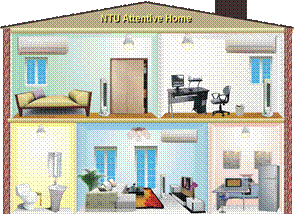M2M-based Anticipatory Reasoning for Contexts and Services
The goal of this project is to build a context-aware home energy saving system using existing M2M infrastructure that reduces power consumption in a home without compromising on user comfort, in a single- or multi-user environment.
PI: Prof. Li-Chen Fu Co-PI: Prof. 吳兆麟
Champion: Dr. Charlie Tai
Most of traditional energy saving systems often need user interventions to manually preset some static energy-saving rules via not readily accessible interfaces. More importantly, these monolithic systems often fail to take users’ contexts and preferences into account. Therefore, we employ the M2M Infrastructure, which allows cost-effective integration and fast deployment of vast amount of remote devices, to achieve context-aware energy-saving and to minimize user's interventions in the determination of energy saving policies. The overall system architecture is illustrated as below. In this system, there are three major components, which are Distributed Hybrid Context (DHC) Inference Engine, Collaborative Energy-Saving (CES) Decision Support Engine, and Ambient Universal Control Interface (AUCI). Unlike the existing approaches often ignoring the context information such as users’ situations and preferences, the DHC Inference Engine infers users’ activities, preferences, and PMV (Predicted Mean Vote) value through techniques of activity recognition (AR), preference recognition (PR), and PMV evaluation; the system then aggregates them into useful context data. With the context data inferred by the DHC Inference Engine and environment factors extracted from environment, the CES Decision Support Engine deals with conflicts between users’ preferences and energy saving policies. That is, the CES Decision Support Engine will provide recommendations to user who selects his/her preferable policy concerning power saving or comfort level based on that policy while taking into accounts all the extractable factors. Finally, we propose a decentralized and friendly control interface called AUCI to present environment or system information in a coherent way to help users to quickly control/configure multiple devices and provide comprehensive device information via readily accessible interfaces so that efforts for human intervention can be minimized. Besides, AUCI also acts as a bridge between internal networks and cloud services, which will further facilitate service innovation for energy saving.
 Fig. 1. Our smart home environment as one testbed for energy-saving evaluations
Fig. 1. Our smart home environment as one testbed for energy-saving evaluationsMembers


Publications
H. Yeh et al., "Cloud-Enabled Adaptive Activity-Aware Energy-Saving System in a Dynamic Environment", in 2011 IEEE Ninth International Conference on Dependable, Autonomic and Secure Computing, pp. 690-696.



C. Wu, L. Fu, "Design and Realization of a Framework for Human–System Interaction in Smart Homes", Systems, Man and Cybernetics, Part A: Systems and Humans, IEEE Transactions on, vol. 42, 02 2012, pp. 15 - 31.



Y. Huang et al., "A Cloud-Based Accessible Architecture for Large-Scale ADL Analysis Services", in 2011 IEEE 4th International Conference on Cloud Computing, pp. 646-653.



Y. C. Yen et al., "Towards an Evidence-Based and Context-Aware Elderly Caring System Using Persuasive Engagement", in Universal Access in Human-Computer Interaction. Context Diversity, C. Stephanidis, Ed., Berlin, Heidelberg: Springer Berlin Heidelberg, 2011, pp. 240–249.



C. Lu et al., "A Sense of Connection: Towards a Personal Wellness Management Ready Society", in 2011 International Joint Conference on Service Sciences, pp. 1-5.



Y. Chiao et al., "I Can't Wait!: Towards a human-centric and smarter convenience store service experience", in International Conference on Social Science and Humanity IPEDR, 2011.



 國立臺灣大學
國立臺灣大學


